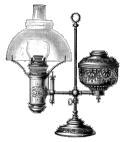Below is a list of terms commonly used to describe lamps and other lighting devices, their component parts, and factors affecting their condition. This list is undoubtedly incomplete and should be considered a "work in progress." It will be amended regularly. I welcome your suggestions for corrections, changes or additions.
The Glossary of Terms is alphabetized. Any terms that appear in green are links to pictures or illustrations that graphically depict that particular term. The Glossary is quite lengthy and I have tried to make it as easy as possible to navigate through it. You can easily get back to the index from any letter heading, or back to the top of the page to the Main Navigation Buttons.
N | O |
P | Q | R | S | T |
U | V | W | X | Y |
Z
N | O | P | Q | R | S | T | U | V | W | X | Y | Z |


 Download the text version* of The Lampworks' Glossary of Lamp & Lighting Terms -
Download the text version* of The Lampworks' Glossary of Lamp & Lighting Terms -